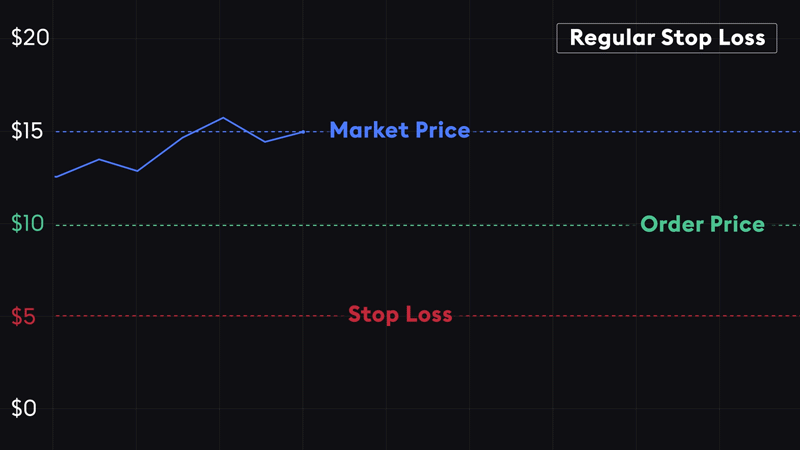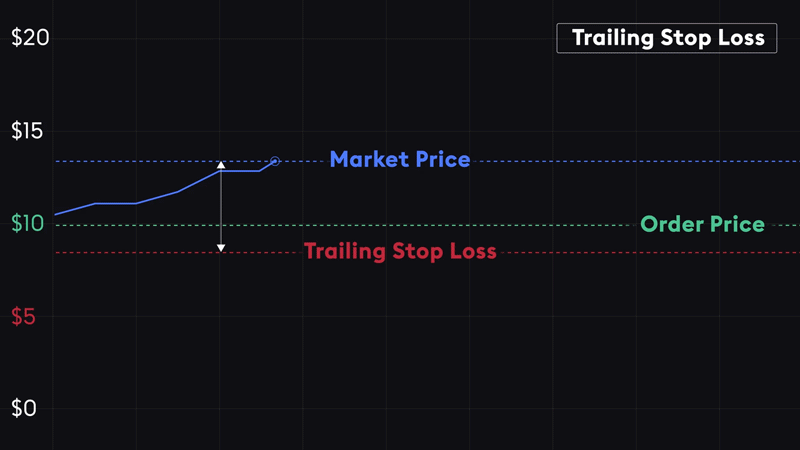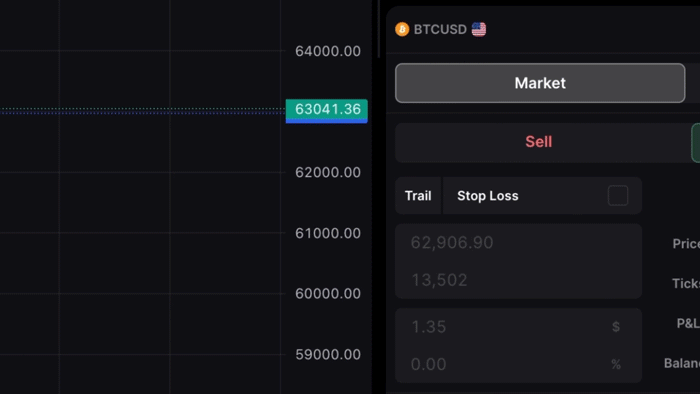What is trailing stop loss?
A trailing stop loss is a type of order that traders use to limit their potential losses while maximizing their gains.
Unlike a regular stop loss that remains at a set level, a trailing stop loss automatically adjusts if the trade moves in a favorable direction.
If the asset’s price rises, the trailing stop will rise with it, maintaining the set distance. If the asset’s price starts to fall, the stop loss doesn’t move, and if the price hits the stop loss level, it triggers a sell order to minimize losses.
Regular stop loss vs. trailing stop loss
The main difference between a trailing stop loss and a regular stop loss is their ability to adapt to changing market conditions. Learn more about Types of orders on TradeLocker.
Regular stop loss
A regular stop loss stays at a predetermined price level. This price doesn’t change unless it is manually adjusted.
For example, the price of an asset might go up and you might not see it during the day. By the time you’re back on the charts, the price drops and your position automatically closes at the price you set. This can result in premature sale during volatile market fluctuations or larger losses if the price drops significantly.

Trailing stop loss
In contrast, a trailing stop loss provides a more flexible approach by moving with the price increases, thus allowing the trade more room to grow while still protecting gains.
For example, if you set a trailing stop loss of $5 below the market price, and the market price increases, the stop loss price increases by the same amount, maintaining the $5 gap. However, if the market price falls, the stop loss price stays put, protecting your gains or limiting your losses.

So, a trailing stop is more flexible than a regular stop-loss order, as it automatically tracks the asset’s price direction and does not have to be manually reset.
Benefits of a trailing stop loss
Understanding and using this feature in your trading strategy has multiple benefits.
1. Automatically adjusts the price
As the market price of an asset increases, the trailing stop loss adjusts itself automatically. This allows traders to stay in the trade longer during a winning streak, potentially increasing profits without the need to manually adjust their stop loss level.
2. Protects profits
The trailing stop loss helps lock in profits by moving up with price increases. If the market turns, the trader’s profits are protected, and the trade is exited before those profits can diminish.
3. Limits losses
It limits potential losses by having a floor that triggers a sale if the price falls to a certain level. This helps manage risk, particularly in volatile markets.
How to set a trailing stop order?
Setting a trailing stop loss involves selecting the asset you wish to trade, choosing the trailing stop option, and specifying the distance from the market price either in percentage or absolute terms.
We wrote a simple guide on How to set a trailing stop loss on TradeLocker.

The key to effectively trading with trailing stop loss is to set it at a distance that is not too close to the current market price to avoid getting stopped out by normal market fluctuations, and not too far to prevent large losses or giving up too much profit.
For example, if you are willing to risk 1% of your account, the trailing stop loss level will always follow 1% under the current market price.
Learn more here:
Conclusion
Trailing Stop Loss allows you to stay in the game longer and potentially increase your profits without constantly monitoring the market.
The one thing we want you to remember…
As the market price goes up, the trailing stop loss goes up by the amount you set.
If the market price falls, the stop loss stays in place, securing your profits and limiting your loss.
This feature is a valuable tool for managing trading risk and is particularly useful for beginners looking to protect their profits.
